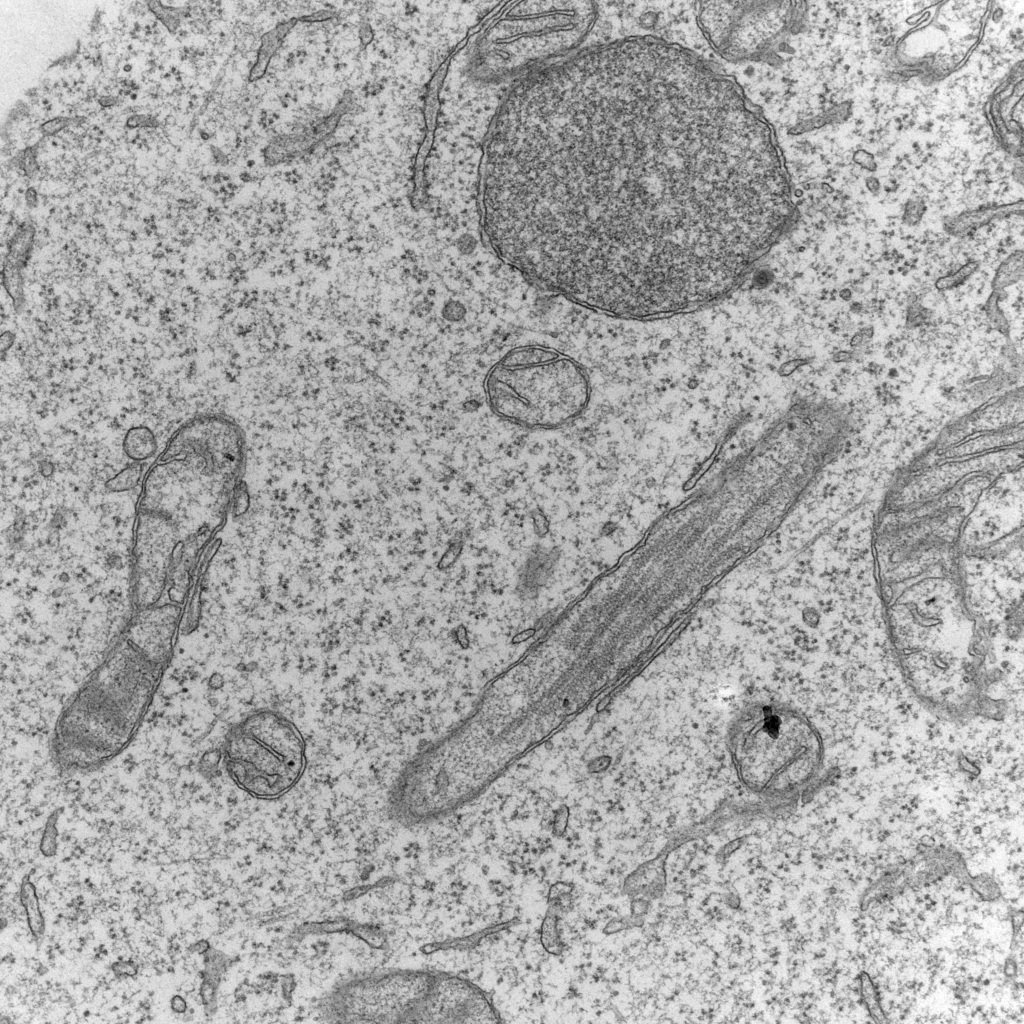Publications
2024
Freitas FP*, Alborzinia H*, Dos Santos AF*, Nepachalovich P, Pedrera L, Zilka O, Inague A, Klein C, Aroua N, Kaushal K et al (2024) 7-Dehydrocholesterol is an endogenous suppressor of ferroptosis. Nature 626: 401-410
(*equal contribution)
2023
Alborzinia H*§, Chen Z*, Yildiz U*, Freitas FP, Vogel FCE, Varga JP, Batani J, Bartenhagen C, Schmitz W, Buchel G et al (2023) LRP8-mediated selenocysteine uptake is a targetable vulnerability in MYCN-amplified neuroblastoma. EMBO Mol Med 15: e18014
(*equal contribution, §corresponding author)
Samarin J, Fabrowski P, Kurilov R, Nuskova H, Hummel-Eisenbeiss J, Pink H, Li N, Weru V, Alborzinia H, Yildiz U et al (2023) Low level of antioxidant capacity biomarkers but not target overexpression predicts vulnerability to ROS-inducing drugs. Redox Biol 62: 102639
2022
Alborzinia H*§, Florez AF*, Kreth S*, Bruckner LM*, Yildiz U, Gartlgruber M, Odoni DI, Poschet G, Garbowicz K, Shao C et al (2022) MYCN mediates cysteine addiction and sensitizes neuroblastoma to ferroptosis. Nat Cancer 3: 471-485
(*equal contribution, §corresponding author)
2021
Florez AF, Alborzinia H (2021) Ferroptosis: Concepts and Definitions. Adv Exp Med Biol 1301: 1-5
2018
Alborzinia H, Ignashkova TI, Dejure FR, Gendarme M, Theobald J, Wolfl S, Lindemann RK, Reiling JH (2018) Golgi stress mediates redox imbalance and ferroptosis in human cells. Commun Biol 1: 210
Baumann J, Ignashkova TI, Chirasani SR, Ramirez-Peinado S, Alborzinia H, Gendarme M, Kuhnigk K, Kramer V, Lindemann RK, Reiling JH (2018) Golgi stress-induced transcriptional changes mediated by MAPK signaling and three ETS transcription factors regulate MCL1 splicing. Mol Biol Cell 29: 42-52
Gaitantzi H, Meyer C, Rakoczy P, Thomas M, Wahl K, Wandrer F, Bantel H, Alborzinia H, Wolfl S, Ehnert S et al (2018) Ethanol sensitizes hepatocytes for TGF-beta-triggered apoptosis. Cell Death Dis 9: 51
2017
Abu El Maaty MA, Alborzinia H, Khan SJ, Buttner M, Wolfl S (2017) 1,25(OH)2D3 disrupts glucose metabolism in prostate cancer cells leading to a truncation of the TCA cycle and inhibition of TXNIP expression. Biochim Biophys Acta Mol Cell Res 1864: 1618-1630
2016
Alborzinia H, Shaikhkarami M, Hortschansky P, Wolfl S (2016) BMP2 Transfer to Neighboring Cells and Activation of Signaling. Traffic
Cheng X, Kim JY, Ghafoory S, Duvaci T, Rafiee R, Theobald J, Alborzinia H, Holenya P, Fredebohm J, Merz KH et al (2016) Methylisoindigo preferentially kills cancer stem cells by interfering cell metabolism via inhibition of LKB1 and activation of AMPK in PDACs. Mol Oncol 10: 806-824
Kim JY, Cheng X, Alborzinia H, Wolfl S (2016) Modified STAP conditions facilitate bivalent fate decision between pluripotency and apoptosis in Jurkat T-lymphocytes. Biochem Biophys Res Commun 472: 585-591
Nwosu ZC, Alborzinia H, Wolfl S, Dooley S, Liu Y (2016) Evolving Insights on Metabolism, Autophagy, and Epigenetics in Liver Myofibroblasts. Frontiers in physiology 7: 191
2015
Cheng X, Yoshida H, Raoofi D, Saleh S, Alborzinia H, Wenke F, Gohring A, Reuter S, Mah N, Fuchs H et al (2015b) Ethyl 2-((4-Chlorophenyl)amino)thiazole-4-carboxylate and Derivatives Are Potent Inducers of Oct3/4. J Med Chem 58: 5742-5750
Gross A, Alborzinia H, Piantavigna S, Martin LL, Wolfl S, Metzler-Nolte N (2015) Vesicular disruption of lysosomal targeting organometallic polyarginine bioconjugates. Metallomics 7: 371-384
Oehninger L, Spreckelmeyer S, Holenya P, Meier SM, Can S, Alborzinia H, Schur J, Keppler BK, Wolfl S, Ott I (2015) Rhodium(I) N-Heterocyclic Carbene Bioorganometallics as in Vitro Antiproliferative Agents with Distinct Effects on Cellular Signaling. J Med Chem 58: 9591-9600
2014
Cheng X, Dimou E, Alborzinia H, Wenke F, Gohring A, Reuter S, Mah N, Fuchs H, Andrade-Navarro MA, Adjaye J et al (2015a) Identification of 2-[4-[(4-Methoxyphenyl)methoxy]-phenyl]acetonitrile and Derivatives as Potent Oct3/4 Inducers. J Med Chem 58: 4976-4983
Cheng X, Holenya P, Can S, Alborzinia H, Rubbiani R, Ott I, Wolfl S (2014) A TrxR inhibiting gold(I) NHC complex induces apoptosis through ASK1-p38-MAPK signaling in pancreatic cancer cells. Mol Cancer 13: 221
Holenya P, Can S, Rubbiani R, Alborzinia H, Junger A, Cheng X, Ott I, Wolfl S (2014) Detailed analysis of pro-apoptotic signaling and metabolic adaptation triggered by a N-heterocyclic carbene-gold(I) complex. Metallomics 6: 1591-1601
Kitanovic I, Can S, Alborzinia H, Kitanovic A, Pierroz V, Leonidova A, Pinto A, Spingler B, Ferrari S, Molteni R et al (2014) A deadly organometallic luminescent probe: anticancer activity of a ReI bisquinoline complex. Chemistry 20: 2496-2507
Maschke M, Alborzinia H, Lieb M, Wolfl S, Metzler-Nolte N (2014) Structure-activity relationship of trifluoromethyl-containing metallocenes: electrochemistry, lipophilicity, cytotoxicity, and ROS production. ChemMedChem 9: 1188-1194
Meyer A, Oehninger L, Geldmacher Y, Alborzinia H, Wolfl S, Sheldrick WS, Ott I (2014) Gold(I) N-heterocyclic carbene complexes with naphthalimide ligands as combined thioredoxin reductase inhibitors and DNA intercalators. ChemMedChem 9: 1794-1800
pincemaille P, Alborzinia H, Dekervel J, Windmolders P, van Pelt J, Cassiman D, Cheneval O, Craik DJ, Schur J, Ott I et al (2014) The plant decapeptide OSIP108 can alleviate mitochondrial dysfunction induced by cisplatin in human cells. Molecules 19: 15088-15102
2013
Alborzinia H, Schmidt-Glenewinkel H, Ilkavets I, Breitkopf-Heinlein K, Cheng X, Hortschansky P, Dooley S, Wolfl S (2013) Quantitative kinetics analysis of BMP2 uptake into cells and its modulation by BMP antagonists. J Cell Sci 126: 117-127
Oehninger L, Stefanopoulou M, Alborzinia H, Schur J, Ludewig S, Namikawa K, Munoz-Castro A, Koster RW, Baumann K, Wolfl S et al (2013) Evaluation of arene ruthenium(II) N-heterocyclic carbene complexes as organometallics interacting with thiol and selenol containing biomolecules. Dalton Trans 42: 1657-1666
2012
Bieda R, Kitanovic I, Alborzinia H, Meyer A, Ott I, Wolfl S, Sheldrick WS (2011) Antileukemic activity and cellular effects of rhodium(III) crown thiaether complexes. Biometals 24: 645-661
Cheng X, Alborzinia H, Merz KH, Steinbeisser H, Mrowka R, Scholl C, Kitanovic I, Eisenbrand G, Wolfl S (2012) Indirubin derivatives modulate TGFbeta/BMP signaling at different levels and trigger ubiquitin-mediated depletion of nonactivated R-Smads. Chem Biol 19: 1423-1436
Geldmacher Y, Splith K, Kitanovic I, Alborzinia H, Can S, Rubbiani R, Nazif MA, Wefelmeier P, Prokop A, Ott I et al (2012) Cellular impact and selectivity of half-sandwich organorhodium(III) anticancer complexes and their organoiridium(III) and trichloridorhodium(III) counterparts. J Biol Inorg Chem 17: 631-646
Kasper C, Alborzinia H, Can S, Kitanovic I, Meyer A, Geldmacher Y, Oleszak M, Ott I, Wolfl S, Sheldrick WS (2012) Synthesis and cellular impact of diene-ruthenium(II) complexes: a new class of organoruthenium anticancer agents. J Inorg Biochem 106: 126-133
Meyer A, Bagowski CP, Kokoschka M, Stefanopoulou M, Alborzinia H, Can S, Vlecken DH, Sheldrick WS, Wolfl S, Ott I (2012) On the biological properties of alkynyl phosphine gold(I) complexes. Angew Chem Int Ed Engl 51: 8895-8899
Nazif MA, Rubbiani R, Alborzinia H, Kitanovic I, Wolfl S, Ott I, Sheldrick WS (2012) Cytotoxicity and cellular impact of dinuclear organoiridium DNA intercalators and nucleases with long rigid bridging ligands. Dalton Trans 41: 5587-5598
2011
Alborzinia H, Can S, Holenya P, Scholl C, Lederer E, Kitanovic I, Wolfl S (2011) Real-time monitoring of cisplatin-induced cell death. PLoS One6: e19714
Geldmacher Y, Kitanovic I, Alborzinia H, Bergerhoff K, Rubbiani R, Wefelmeier P, Prokop A, Gust R, Ott I, Wolfl S et al (2011) Cellular selectivity and biological impact of cytotoxic rhodium(III) and iridium(III) complexes containing methyl-substituted phenanthroline ligands. ChemMedChem 6: 429-439
Hackenberg F, Oehninger L, Alborzinia H, Can S, Kitanovic I, Geldmacher Y, Kokoschka M, Wolfl S, Ott I, Sheldrick WS (2011) Highly cytotoxic substitutionally inert rhodium(III) tris(chelate) complexes: DNA binding modes and biological impact on human cancer cells. J Inorg Biochem 105: 991-999
Oehninger L, Alborzinia H, Ludewig S, Baumann K, Wolfl S, Ott I (2011) From catalysts to bioactive organometallics: do Grubbs catalysts trigger biological effects? ChemMedChem 6: 2142-2145
Rubbiani R, Can S, Kitanovic I, Alborzinia H, Stefanopoulou M, Kokoschka M, Monchgesang S, Sheldrick WS, Wolfl S, Ott I (2011) Comparative in vitro evaluation of N-heterocyclic carbene gold(I) complexes of the benzimidazolylidene type. J Med Chem 54: 8646-8657
2010
Dransfeld CL, Alborzinia H, Wolfl S, Mahlknecht U (2010a) Continuous multiparametric monitoring of cell metabolism in response to transient overexpression of the sirtuin deacetylase SIRT3. Clin Epigenetics 1: 55-60
Dransfeld CL, Alborzinia H, Wolfl S, Mahlknecht U (2010b) SIRT3 SNPs validation in 640 individuals, functional analyses and new insights into SIRT3 stability. Int J Oncol 36: 955-960
Rubbiani R, Kitanovic I, Alborzinia H, Can S, Kitanovic A, Onambele LA, Stefanopoulou M, Geldmacher Y, Sheldrick WS, Wolber G et al(2010) Benzimidazol-2-ylidene gold(I) complexes are thioredoxin reductase inhibitors with multiple antitumor properties. J Med Chem 53: 8608-8618
2009
Hille A, Ott I, Kitanovic A, Kitanovic I, Alborzinia H, Lederer E, Wolfl S, Metzler-Nolte N, Schafer S, Sheldrick WS et al (2009) [N,N'-Bis(salicylidene)-1,2-phenylenediamine]metal complexes with cell death promoting properties. J Biol Inorg Chem 14: 711-725
2008
Harlos M, Ott I, Gust R, Alborzinia H, Wolfl S, Kromm A, Sheldrick WS (2008) Synthesis, biological activity, and structure-activity relationships for potent cytotoxic rhodium(III) polypyridyl complexes. J Med Chem 51: 3924-3933
Schatzschneider U, Niesel J, Ott I, Gust R, Alborzinia H, Wolfl S (2008) Cellular uptake, cytotoxicity, and metabolic profiling of human cancer cells treated with ruthenium(II) polypyridyl complexes [Ru(bpy)2(N--N)]Cl2 with N--N=bpy, phen, dpq, dppz, and dppn. ChemMedChem 3: 1104-1109


